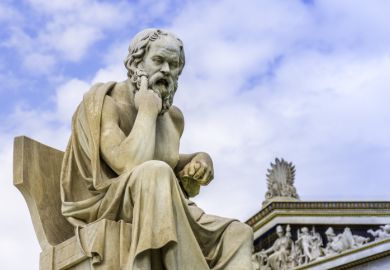A compulsion to believe that sight is the most important of our senses is one of the occupational diseases of professional painters, draughtsmen, engravers and graphic designers of all kinds. Even the great are not immune. Leonardo da Vinci was so anxious to prove that painting was superior to poetry that he came up with one of the worst arguments you will ever find in the history of the arts. Poetry, he claimed, is an oral art, whereas painting is a visual art. But in the hierarchy of the human senses the eye is nobler than the ear. This is demonstrated, he thought, by the fact that a deaf person is perfectly capable of appreciating a painting, whereas a blind person is severely handicapped in appreciating a poem, unless the poet speaks only of things invisible. Therefore, concludes Leonardo, the art of the painter is superior to that of the poet.
The nagging doubt that undermines such claims is the suspicion that visual art, as Plato held, is based on deception. For Leonardo's generation, Alberti's exposition of the rules of monocular perspective could be read as a treatise on how to deceive the innocent eye of the viewer. Can a sense so susceptible to trickery really be nobler than any other?
Although no longer posed in Renaissance terms, the question has never gone away. It surfaces repeatedly in Alan Fletcher's The Art of Looking Sideways . Not that the title gives much of a clue to the contents, which span the author's sidelong and fleeting glances at everything from human evolution to fractal geometry. The book itself looks like a cross between an illustrated dictionary of quotations and a volume of concrete poetry, put together by someone who thought it was about time that the scrapbook was elevated to the status of cultural icon.
Looking sideways turns out to be an understatement. You need to look sideways, backwards, diagonally and upside-down to scan some of the pages. You will also find it useful to have a magnifying glass on hand to read text printed in a ludicrously small font size, and a mirror to read text printed in mirror-image reversal. Particularly taxing are the lines in minuscule letters running deep into the gutter at ninety degrees from the horizontal. Their decipherment requires curiosity, patience and muscular dexterity. At this point you may feel unsure whether the book is a leg-pull or a solemn piece of postmodern pretentiousness. Either way, the result cannot be recommended for bedtime browsing, since it would take a small derrick or crane to hoist its glossy 2kg bulk into a convenient reading position over your bed. It will hardly do on the coffee table either, unless you want your visitors to risk a sprained wrist.
Inside the front cover, we are informed that the book is "a primer in visual intelligence". But the author's cryptic preface stops short of telling us what "visual intelligence" is supposed to be. Perhaps we are expected to use our initiative and start by looking up the chapter headed "Intelligence". This occupies four double-spread pages sandwiched between chapters on "Automaton" and "Brain". Its principal image is a blown-up photograph of an army ant marching off with a micro-chip. The accompanying text tells us that army ants can perform feats of organisation that match those of any human society. "They do everything but watch television."
Presumably watching television is the ultimate manifestation of visual intelligence. We breathe a sigh of relief: it was a close thing.
The same chapter also has brief sections on "Emotional intelligence", "Artificial intelligence", "Computerspeak" and "Deep Blue", from which it emerges that Fletcher does not think much of the idea that any machine could be intelligent. The reason, he tells us, is that intelligence is a matter of conceptualising, not of calculating. Another sigh of relief: human beings are still one step ahead of the competition. But it leaves an awkward question about those army ants and whether they conceptualise. And how one could do much calculating without conceptualising remains unclear.
To confuse matters further, a page of assorted quotations about intelligence, ranging from Aldous Huxley to Jean Baudrillard, seems to establish beyond question that conceptualisations of intelligence vary from one pundit to the next. To round it all off, there is a reproduction of a Mensa advertisement inviting readers to assess their own intelligence. Fletcher evidently does not think much of Mensa either. He comments disparagingly: "The grammar of the advertisement text wouldn't get a member of Mensa past a rudimentary English test, but that's nothing to do with IQ - just common sense."
From all this, we gather that intelligence is a topic on which Fletcher holds strong views. He is trying to warn us about what intelligence is not. The problem is trying to work out what Fletcher thinks intelligence actually is, and, more specifically, visual intelligence.
Having drawn a blank with the "Intelligence" chapter, one might feel that the next best bet is the chapter on "Seeing". This is introduced by a cautionary pronouncement from Goethe: "The hardest thing to see is what is in front of your eyes." The ensuing discussion gets off to a bad start with the rash claim: "Theoretically, everyone is capable of remembering everything that ever happened to them and perceiving everything that's happening around them." Just as you are wondering in what far-fetched realm of theory this axiom was ever deemed to hold, your eye is drawn to a minute and enigmatic footnote to "theoretically". It reads: "The word THEORY derives from the Greek word 'to behold'." Even if this piece of etymological information were more reliable than it is, it would not help very much in accounting for the way the word was used when borrowed into English in the 16th century. It would have been more relevant to say something about what Plato, Aristotle and Plotinus understood theoria to be.
According to Fletcher: "We only notice things that are directly relevant to our daily business." The eye is a lazy organ, reducing our environment to "visual muzak". The eye sleeps even when wide open, "until the mind wakes it with a question". If this is Fletcher's honest account of his own everyday visual experience, all one can say is that someone should have referred him to a competent optician years ago, and perhaps to a psychologist as well. These are curious credentials for the author of a "primer of visual intelligence".
Although he urges us to keep looking, and complains that "most people live with a bag over their head", it is never quite clear that looking will do us much good. The unreliability of the eye is a constant leitmotif throughout the book. Visual illusion is one of Fletcher's obsessions. He is worried by the fact that he can commission an artist to paint a copy of Modigliani's Seated Nude , which is visually indistinguishable from the original. To prove it, he shows photographs of both side by side and challenges you to tell "t'other from which".
Then the dear old duck-rabbit makes the expected guest appearance. (When will some philosophical farmer with a post-Wittgensteinian shotgun do the decent thing and put the misshapen monster out of its misery?) Fletcher boasts that his duck-rabbit is "the original image" and not one of the "bastardised versions" that usually appear in "popular science books". But by now his boast fails to convince: he has primed us with enough visual intelligence to know that it could not be the original image, but only a copy (or did we get that bit wrong?). Along with the duck-rabbit come the Necker cube, the Kanizsa triangle, Penrose drawings and pencils that appear longer or shorter than they are. Parts of the book begin to look like dumbed-down versions of classics such as Richard Gregory's The Intelligent Eye or Ernst Gombrich's Art and Illusion . The reader is even given little tests to see who is visually bright and who is not. (Answers provided in the back of the book, in approved pedagogic tradition.) It is not the recycling of hackneyed material that is boring so much as Fletcher's complete failure to put it in any interesting perspective. The scrapbook formula seems perversely designed to preclude that, and one begins to suspect that the author himself does not understand 50 per cent of the clever sayings he quotes. The artists he plunders for insights about vision are, as one might expect, not Rembrandt and Titian but Magritte and Escher. But all he can find to say about Magritte's Ceci n'est pas une pipe is the penetrating observation that indeed it is not a pipe but a painting of a pipe, thus missing the point of the artist's caption. On writing, where the verbal and visual worlds meet, he trots out the hoary old orthodoxy that it all began with pictography. But then he would, wouldn't he? Similarly, his visual blinkers lead him to see thinking as "drawing in your head", instead of drawing in your head as just one kind of thinking.
Visual memory is another missed opportunity. His mini-essay on memory begins: "One afternoon in 1909 Marcel Proust dipped a biscuit into his tea." A la Recherche du Temps Perdu was the result. In case we are disinclined to believe this, Fletcher recalls a similar episode from his own childhood, when the Latin master, Mr Willink, taught the class how to memorise Latin verbs by visualising the forms hooked on to the branches, leaves, twigs and flowers of a tree. "Fifty years later I can't recall the verbs but I can remember the tree." From the Proustian personal anecdote we pass on to legendary feats of memory. These include the ancient story of Simonides recalling the places where everyone had been sitting when the roof fell in. Locational mnemonic systems are recommended for those who, like the author, "can't even remember which sock I put on first when I get up in the morning". Why anyone should wish to remember that particular priority is not vouchsafed. This is writing that would struggle to get published in the school magazine.
Fletcher tells us he is intrigued by useless information and his book is "a journey without a destination". It nevertheless teaches at least one lesson: banality can neither be masked behind a thousand snippets of borrowed wisdom, nor redeemed by as many pages of smart-aleck typography. This is a book for people who enjoy being bedazzled by both at once.
Roy Harris is emeritus professor of general linguistics, University of Oxford.
The Art of Looking Sideways
Author - Alan Fletcher
ISBN - 0 7148 3449 1
Publisher - Phaidon
Price - £24.95
Pages - 1,066
Register to continue
Why register?
- Registration is free and only takes a moment
- Once registered, you can read 3 articles a month
- Sign up for our newsletter
Subscribe
Or subscribe for unlimited access to:
- Unlimited access to news, views, insights & reviews
- Digital editions
- Digital access to THE’s university and college rankings analysis
Already registered or a current subscriber?



